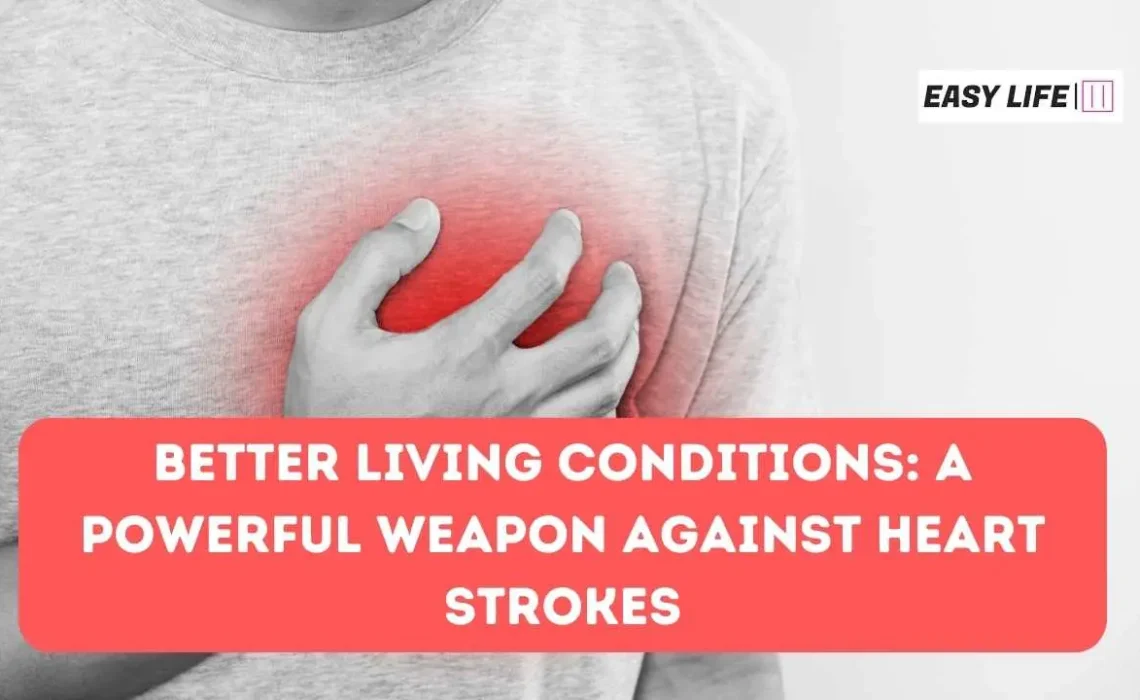Heart strokes, the leading cause of death and disability worldwide, claim millions of lives each year. While genetics and individual health choices play a role, emerging research suggests that better living conditions can be a powerful weapon in the fight against this devastating condition.
Table of Contents
ToggleThe Link Between Living Conditions and Heart Health:
Studies have shown a clear correlation between socio-economic factors and cardiovascular health. Individuals living in poverty or disadvantaged neighborhoods often face:
- Poor housing: Inadequate shelter can expose residents to environmental hazards like mold, lead, and air pollution, all linked to increased stroke risk.
- Limited access to healthy food: Grocery deserts, areas lacking fresh fruits and vegetables, can lead to unhealthy diets high in processed foods, contributing to obesity, diabetes, and heart disease.
- Stressful environments: Chronic stress caused by factors like violence, noise, and lack of green spaces can elevate blood pressure and inflammation, major risk factors for strokes.
- Limited access to healthcare: Disparities in healthcare access can lead to undiagnosed and untreated conditions that contribute to stroke risk.
Investing in Better Living Conditions Saves Lives:
Addressing these challenges through targeted interventions can significantly reduce stroke risk and improve overall health outcomes. Here’s how:
- Affordable, safe housing: Investing in quality, affordable housing reduces exposure to environmental hazards and promotes healthy living.
- Access to healthy food: Supporting initiatives like community gardens, farmers markets, and grocery store subsidies increases access to nutritious food choices.
- Green spaces and stress reduction: Creating parks, green spaces, and community centers can provide opportunities for physical activity and relaxation, lowering stress levels.
- Improved healthcare access: Expanding healthcare access and targeted preventative screenings can ensure timely diagnosis and treatment of risk factors.
Read also: Half in the Dark: Why Heart Disease, America’s Biggest Killer
The Ripple Effect of Better Living:
The benefits of improving living conditions go beyond individual health. Studies show that communities with better living conditions experience:
- Reduced healthcare costs: By preventing strokes and other chronic diseases, communities save on healthcare expenditures.
- Increased economic productivity: A healthier population is a more productive workforce, boosting the local economy.
- Stronger social fabric: Improved living conditions foster community cohesion and well-being, leading to a safer and more vibrant society.
Investing in better living conditions is not just about charity, it’s about smart public health policy. By addressing the social determinants of health. We can create a society where everyone has the opportunity to live a long, healthy life, free from the threat of strokes and other preventable diseases.
Let’s make better living conditions a reality for all and unlock a healthier, happier future for everyone.
Note: This article provides a general overview. For specific details and data, please refer to relevant scientific studies and reports.
External Resources on Living Conditions and Heart Strokes:
Research Studies:
- “Socioeconomic Disparities in Stroke: A Review of Social Determinants and Interventions”: https://www.ncbi.nlm.nih.gov/pmc/articles/PMC9401090/
- “Housing and Health: The Link Between Housing Conditions and Chronic Disease”: https://www.cdc.gov/chronicdisease/index.htm
- “The Impact of Neighborhood Green Space on Blood Pressure and Hypertension”: https://pubmed.ncbi.nlm.nih.gov/4069459/
Organizations and Initiatives:
- World Health Organization – Social Determinants of Health: https://www.who.int/health-topics/social-determinants-of-health
- Centers for Disease Control and Prevention – Social Determinants of Health: https://www.cdc.gov/about/sdoh/index.html
- The National Low Income Housing Coalition: https://nlihc.org/
- The Campaign to End Childhood Hunger: https://frac.org/about/campaign-end-childhood-hunger
- The Trust for Public Land: https://www.tpl.org/
Reports and Policy Briefs:
- “The Economic Cost of Stroke: A Report by the American Heart Association/American Stroke Association”: https://www.heart.org/en/about-us/statements-and-policies/american-heart-association-and-american-stroke-association-linking-policy
- “The Future of Housing in America”: https://www.jchs.harvard.edu/improving-americas-housing-2023
- “Investing in Parks: The Economic Impact of Local Parks”: https://www.tpl.org/parks-and-an-equitable-recovery-parkscore-report
Additional Resources:
- Stroke Association: https://www.stroke.org/en/
- American Heart Association: https://www.heart.org/
- National Healthy Homes Partnership: https://www.greenandhealthyhomes.org/
This list is not exhaustive, but it provides a starting point for further exploration of the link between living conditions and heart strokes. It’s important to note that research in this area is ongoing, and the specific links and impacts may vary depending on the context.









